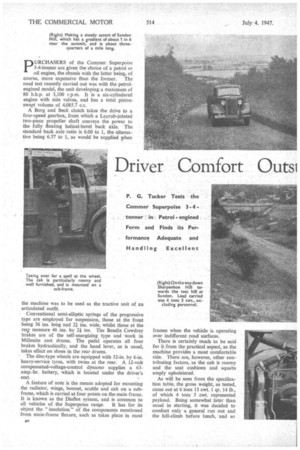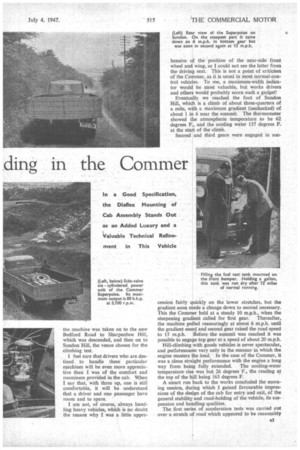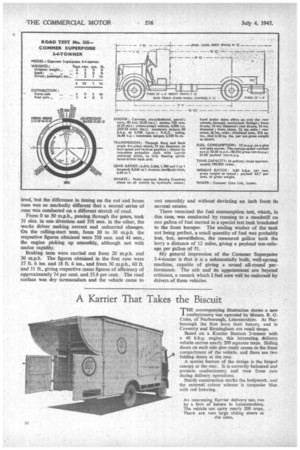Driver Comfort Outsi ding in the Commer
Page 38

Page 39

Page 40

If you've noticed an error in this article please click here to report it so we can fix it.
pURCHASERS of the Comer. Superpoise 3-4-tonner are given the choice of a petrol or oil engine, the chassis with the latter being, of course, more expensive than the former. . The road test recently carried out was with the petrolengined model, the unit developing a maximum of 80 b.h.p. at 3,100 r.p.m. It is a six-cylindered engine with side valves, and has a total pistonswept volume of 4,085.7 c.c.
A Borg and Beck clutch takes the drive to a four-speed gearbox, from which a Layrub-jointed two-piece propeller shaft conveys the power to the fully floating helical-bevel back axle. The standard back axle ratio is 6.00 to 1, the alternative being 6.57 to I, as would be supplied viten the machine was to be used as the tractive unit of an articulated outfit.
Conventional semi-elliptic springs of the progressive type are employed for suspension, those at the front being 36 ins, long and 2/ ins, wide, whilst those at the rear measure 46 ins. by 21 ins. The Bendix Cowdrey brakes are of the self-energizing type and work in Millenite cast drums. The pedal operates all four brakes hydraulically, and the hand lever, as is usual, takes effect on shoes in the rear drums.
The disc-type wheels are equipped with 32-in. by 6-in. heavy-service tyres, with twins at the rear. A 12-volt compensated-voltage-control dynamo supplies a 63amp.-hr. battery, which is located under the driver's seat.
A feature of note is the means adopted for mounting the radiator, wings, bonnet, scuttle and cab on a subframe, which is carried at four points on the main frame. It is known as the Diaflex system, and is common to all vehicles of the Superpoise range. It has for its object the " insulation" of the components mentioned from main-frame flexure, such as takes place in most frames when the vehicle is operating over indifferent road surfaces.
There is certainly much to be said for it from the practical aspect, as the machine provides a most comfortable ride. There are, however, other contributing factors, as the cab is roomy and the seat cushions and squabs amply upholstered.
As will be seen from the specification table, the gross weight, as tested, came out at 6 tons 13 cwt. I qr. 14 lb., of which 4 tons 5 cwt. represented payload. Being somewhat later than usual in starting, it was decided to conduct only a general run out and the hill-climb before lunch, and so tne machine was taken on to the new Bedford Road to Sharpenhoe Hill, which was descended, and then on to Sundon Hill, the venue chosen for the climbing test.
I feel sure that drivers who are destined to handle these particular machines will be even more appreciative than I was of the comfort and roominess provided in the cab. When I say that, with three up, one is still comfortable, it will be understood that a driver and one passenger have room and to spare. • I am not, of course, always handling heavy vehicles, which is no doubt the reason why I was a little appre hensive of the position of the near-side front wheel and wing, as I could not see the latter from the driving seat. This is not a point of criticism of the Commer, as it is usual in most normal-control vehicles. To me, a maximum-width indicator would be most valuable, but works drivers and others would probably scorn such a gadget!
Eventually we reached the foot of Sundon Hill, which is a climb of about three-quarters of a mile, with a maximum gradient (unchecked) of about 1 in 6 near the summit. The thermometer showed the atmospheric temperature to be 62 degrees F., and the cooling water 137 degrees F. at the start of the climb.
Second and third gears were engaged in suc cession fairly quickly on the lower stretches, but the gradient soon made a change down to second necessary. This the Commer held at a steady 10 m.p.h., when the steepening gradient called for first gear. Thereafter, the machine pulled reassuringly at about 6 m.p.h. until the gradient eased and second gear raised the road speed to 15 m.p.h. Before the summit was reached it was possible to engage top gear at a speed of about 20 m.p.h.
Hill-climbing with goods vehicles is never spectacular, and performances vary only in the manner in which the engine masters the load. In the case of the Commer, it was a clean straight performance with the engine a long way from being fully extended. The cooling-water temperature rise was but 26 degrees F., the reading at the top of the hill being 163 degrees F.
A smart run back to the works concluded the morning session, during which I gained favourable impressions of the design of the cab for entry and exit, of the general stability and road-holding of the vehicle, its suspension and handling qualities. The first series of acceleration tests was carried out over a stretch of road which appeared to be reasonably level, but the difference in timing on the out and home runs was so markedly different that a second series of runs was conducted on a different stretch of road.
From 0 to 30 m.p.h., passing through the gears, took 31 secs. in one direction and 35/ secs. in the other, the works driver making correct and unhurried changes. On the rolling-start tests, from 10 to 30 m.p.h. the respective figures obtained were 331 sees. and 41 secs., the engine picking up smoothly, although not with undue rapidity.
Braking tests were carried out from 20 m.p.h. and 30 m.p.h. The figures obtained in the first case were 17 ft. 6 ins. and 18 ft. 6 ins., and from 30 m.p.h., 60 ft. and 51 ft., giving respective mean figures of efficiency of approximately 74 per cent. and 55.8 per cent. The road surface was dry tarmacadam and the vehicle came to rest smoothly and without deviating an inch from its normal course.
There remained the fuel consumption test, which, in this case, was conducted by running to a standstill on one gallon of fuel carried in a special test tank bracketed to the front bumper. The sealing washer of the tank not being perfect, a small quantity of fuel was probably lost, but, nevertheless, the measured gallon took the lorry a distance of 12 miles, giving a payload ton-mileage per gallon of 51.
My general impression of the Cornmer Superpoise 3-4-tonner is that it is a substantially built, well-sprung machine, capable of giving a sound all-round performance. The cab and its appointment are beyond criticism, a remark which I feel sure will be endorsed by drivers of these vehicles.












































































